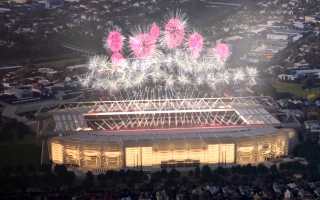Auckland Waterfront Stadium
| Capacity | 50 000 |
|---|---|
| Country | New Zealand |
| City | Auckland |
| Clubs | – |
| Category | Design outdated |
| Cost | NZ$ 1.8 B ($1.1 B) |
| Construction | ? |
| Design | Phil O’Reilly, Peddle Thorp, HOK Architecture |
Advertisement
Auckland Waterfront Stadium – design description
The idea of Auckland's new main stadium at Bledisloe Wharf dates back to 2006, though this precise vision was born in 2017, years after the first one was already scrapped. Created by architect Phil O’Reilly, the idea was nicknamed The Crater as it envisioned a seating bowl entirely sunken beneath sea level.
The concept soon caught traction and The Auckland Waterfront Stadium consortium was soon formed, providing a strong legal, engineering and financial backing for the project. Aside from O’Reilly himself, also teams from Peddle Thorp and global giant HOK got involved in the design.
Their work's outcome ensures that the auditorium remains embedded in the seabed, while also providing a semi-open seaside concourse around it, protected by a spacious, potentially iconic canopy. The proposed stadium also lacks major issues of the 2006 proposal, ensuring that stadium scale isn't too imposing.
Slightly downsized from the initial vision, the new seating bowl would hold 50,000 people. It's designed, however, with downsizing in mind for smaller events and temporary expansion to as many as 65,000 people. Crowd circulation is considered efficient, while access to the stadium is provided by proximity of the city's largest public transport hub. Underground parking would also be included within the wharf.
Because Auckland authorities have excluded the possibility of spending public resources on such project, the consortium found a plan to finance it entirely privately. In order to do so, investors would require, however, vast space for secondary uses both within Bledisloe Wharf and Eden Park stadium, which would become obsolete when its waterfront successor opens.
Eden Park would be transformed into a residential development, while Bledisloe would receive 2,500 apartments and as much as 360,000 m2 of mixed use space, enough to provide 6,000 jobs. Should these conditions be feasible for the city of Auckland, the stadium should be ready within 10 years from announcement.
The Auckland Waterfront Stadium project competed with the Eden Park expansion concept (Eden Park 2.1 project), as well as two other visions to build new stadiums in downtown Auckland (Te Tōangaroa Auckland Stadium and National Stadium at Wynyard Point). The final choice of Auckland councillors, however, was to expand Eden Park.
Advertisement
Renderings
Related news
2025
2023
2019
2018
-

New Zealand: Auckland's sunken stadium to be shelved?
As iconic as it may be, the proposed 50,000-seater sunken into the harbor seabed isn't convincing for everyone. Following the city council's first talks with proponents of the stadium, there are still major doubts.
-

New design: First auditorium embedded into seabed
Like a crater in the sea, this 50,000-seat stadium would offer an auditorium sunken below sea level. This minimises its outer scale, leaving only elegant canopy hovering above the harbor.

 StadiumDB
StadiumDB





